Examining Women's Role in Islamic Militancy: Dissent Essay
VerifiedAdded on 2022/12/23
|8
|3879
|2
Essay
AI Summary
This essay, originally published in Dissent magazine, examines the complex issue of women's involvement in Islamic militancy, particularly focusing on the case of Aafia Siddiqui and the appeal of groups like ISIS. It explores the motivations of women who join these organizations, analyzing their politi...
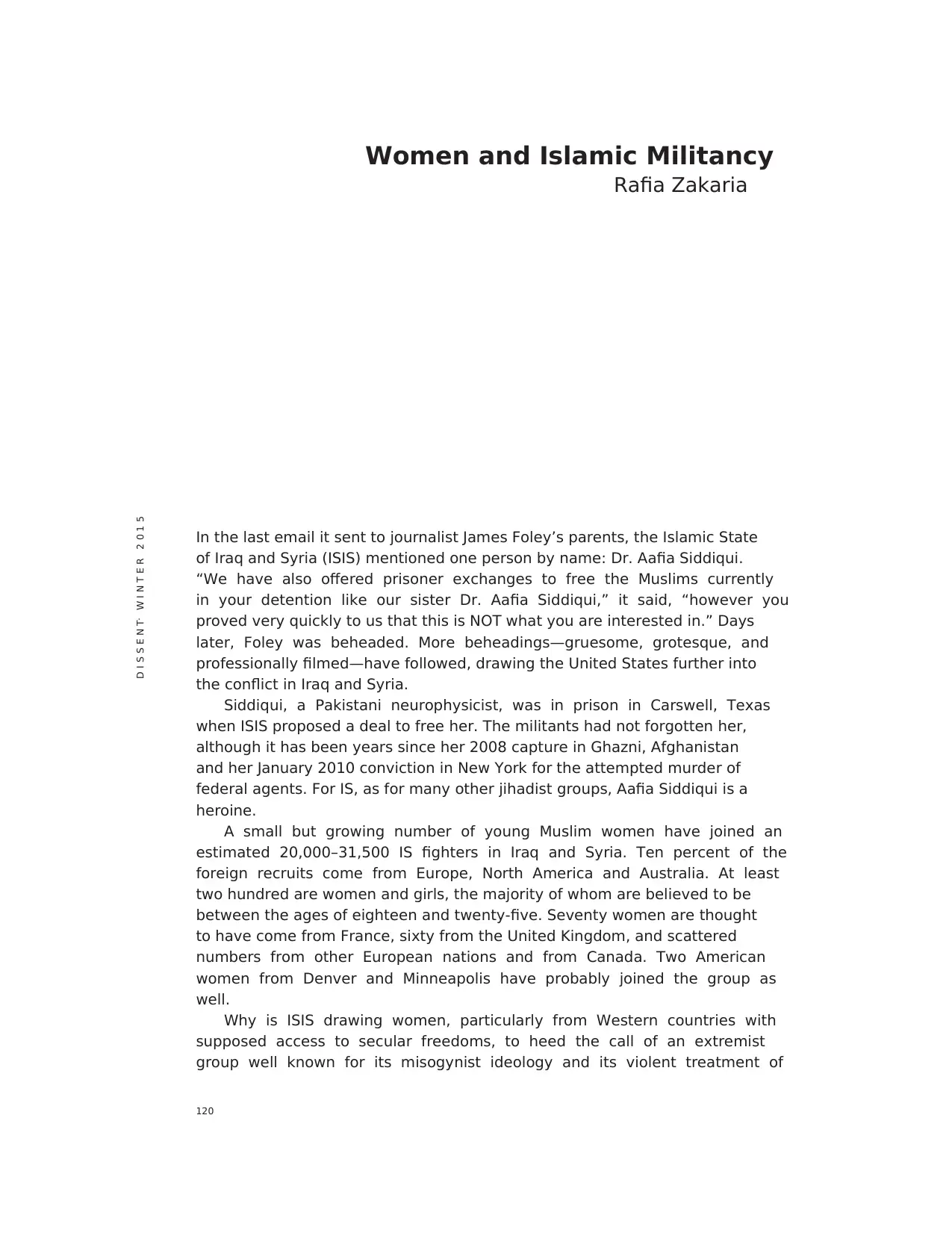
120
D I S S E N T· W I N T E R 2 0 1 5
In the last email it sent to journalist James Foley’s parents, the Islamic State
of Iraq and Syria (ISIS) mentioned one person by name: Dr. Aafia Siddiqui.
“We have also offered prisoner exchanges to free the Muslims currently
in your detention like our sister Dr. Aafia Siddiqui,” it said, “however you
proved very quickly to us that this is NOT what you are interested in.” Days
later, Foley was beheaded. More beheadings—gruesome, grotesque, and
professionally filmed—have followed, drawing the United States further into
the conflict in Iraq and Syria.
Siddiqui, a Pakistani neurophysicist, was in prison in Carswell, Texas
when ISIS proposed a deal to free her. The militants had not forgotten her,
although it has been years since her 2008 capture in Ghazni, Afghanistan
and her January 2010 conviction in New York for the attempted murder of
federal agents. For IS, as for many other jihadist groups, Aafia Siddiqui is a
heroine.
A small but growing number of young Muslim women have joined an
estimated 20,000–31,500 IS fighters in Iraq and Syria. Ten percent of the
foreign recruits come from Europe, North America and Australia. At least
two hundred are women and girls, the majority of whom are believed to be
between the ages of eighteen and twenty-five. Seventy women are thought
to have come from France, sixty from the United Kingdom, and scattered
numbers from other European nations and from Canada. Two American
women from Denver and Minneapolis have probably joined the group as
well.
Why is ISIS drawing women, particularly from Western countries with
supposed access to secular freedoms, to heed the call of an extremist
group well known for its misogynist ideology and its violent treatment of
Women and Islamic Militancy
Rafia Zakaria
D I S S E N T· W I N T E R 2 0 1 5
In the last email it sent to journalist James Foley’s parents, the Islamic State
of Iraq and Syria (ISIS) mentioned one person by name: Dr. Aafia Siddiqui.
“We have also offered prisoner exchanges to free the Muslims currently
in your detention like our sister Dr. Aafia Siddiqui,” it said, “however you
proved very quickly to us that this is NOT what you are interested in.” Days
later, Foley was beheaded. More beheadings—gruesome, grotesque, and
professionally filmed—have followed, drawing the United States further into
the conflict in Iraq and Syria.
Siddiqui, a Pakistani neurophysicist, was in prison in Carswell, Texas
when ISIS proposed a deal to free her. The militants had not forgotten her,
although it has been years since her 2008 capture in Ghazni, Afghanistan
and her January 2010 conviction in New York for the attempted murder of
federal agents. For IS, as for many other jihadist groups, Aafia Siddiqui is a
heroine.
A small but growing number of young Muslim women have joined an
estimated 20,000–31,500 IS fighters in Iraq and Syria. Ten percent of the
foreign recruits come from Europe, North America and Australia. At least
two hundred are women and girls, the majority of whom are believed to be
between the ages of eighteen and twenty-five. Seventy women are thought
to have come from France, sixty from the United Kingdom, and scattered
numbers from other European nations and from Canada. Two American
women from Denver and Minneapolis have probably joined the group as
well.
Why is ISIS drawing women, particularly from Western countries with
supposed access to secular freedoms, to heed the call of an extremist
group well known for its misogynist ideology and its violent treatment of
Women and Islamic Militancy
Rafia Zakaria
Secure Best Marks with AI Grader
Need help grading? Try our AI Grader for instant feedback on your assignments.
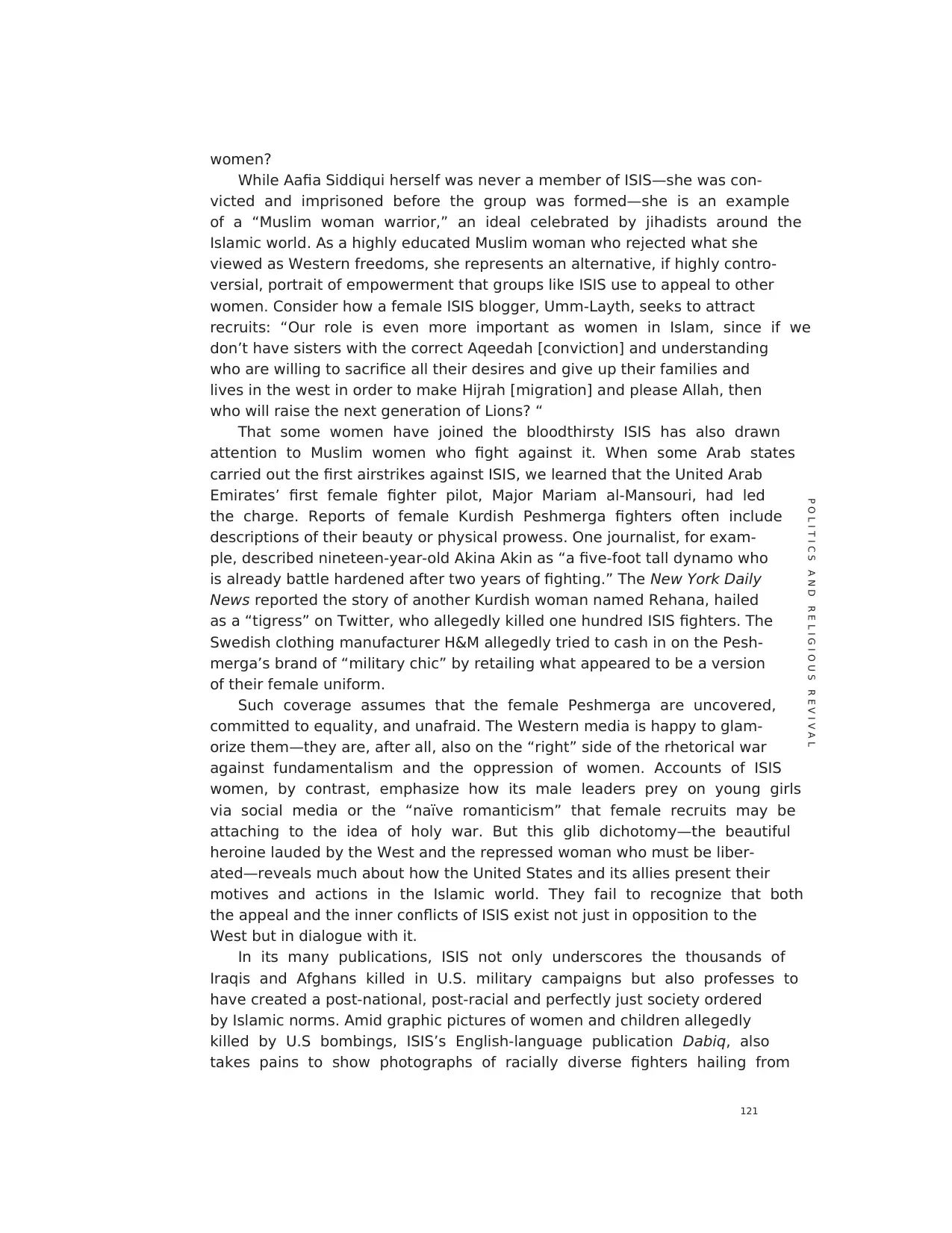
121
P O L I T I C S A N D R E L I G I O U S R E V I V A L
women?
While Aafia Siddiqui herself was never a member of ISIS—she was con-
victed and imprisoned before the group was formed—she is an example
of a “Muslim woman warrior,” an ideal celebrated by jihadists around the
Islamic world. As a highly educated Muslim woman who rejected what she
viewed as Western freedoms, she represents an alternative, if highly contro-
versial, portrait of empowerment that groups like ISIS use to appeal to other
women. Consider how a female ISIS blogger, Umm-Layth, seeks to attract
recruits: “Our role is even more important as women in Islam, since if we
don’t have sisters with the correct Aqeedah [conviction] and understanding
who are willing to sacrifice all their desires and give up their families and
lives in the west in order to make Hijrah [migration] and please Allah, then
who will raise the next generation of Lions? “
That some women have joined the bloodthirsty ISIS has also drawn
attention to Muslim women who fight against it. When some Arab states
carried out the first airstrikes against ISIS, we learned that the United Arab
Emirates’ first female fighter pilot, Major Mariam al-Mansouri, had led
the charge. Reports of female Kurdish Peshmerga fighters often include
descriptions of their beauty or physical prowess. One journalist, for exam-
ple, described nineteen-year-old Akina Akin as “a five-foot tall dynamo who
is already battle hardened after two years of fighting.” The New York Daily
News reported the story of another Kurdish woman named Rehana, hailed
as a “tigress” on Twitter, who allegedly killed one hundred ISIS fighters. The
Swedish clothing manufacturer H&M allegedly tried to cash in on the Pesh-
merga’s brand of “military chic” by retailing what appeared to be a version
of their female uniform.
Such coverage assumes that the female Peshmerga are uncovered,
committed to equality, and unafraid. The Western media is happy to glam-
orize them—they are, after all, also on the “right” side of the rhetorical war
against fundamentalism and the oppression of women. Accounts of ISIS
women, by contrast, emphasize how its male leaders prey on young girls
via social media or the “naïve romanticism” that female recruits may be
attaching to the idea of holy war. But this glib dichotomy—the beautiful
heroine lauded by the West and the repressed woman who must be liber-
ated—reveals much about how the United States and its allies present their
motives and actions in the Islamic world. They fail to recognize that both
the appeal and the inner conflicts of ISIS exist not just in opposition to the
West but in dialogue with it.
In its many publications, ISIS not only underscores the thousands of
Iraqis and Afghans killed in U.S. military campaigns but also professes to
have created a post-national, post-racial and perfectly just society ordered
by Islamic norms. Amid graphic pictures of women and children allegedly
killed by U.S bombings, ISIS’s English-language publication Dabiq, also
takes pains to show photographs of racially diverse fighters hailing from
P O L I T I C S A N D R E L I G I O U S R E V I V A L
women?
While Aafia Siddiqui herself was never a member of ISIS—she was con-
victed and imprisoned before the group was formed—she is an example
of a “Muslim woman warrior,” an ideal celebrated by jihadists around the
Islamic world. As a highly educated Muslim woman who rejected what she
viewed as Western freedoms, she represents an alternative, if highly contro-
versial, portrait of empowerment that groups like ISIS use to appeal to other
women. Consider how a female ISIS blogger, Umm-Layth, seeks to attract
recruits: “Our role is even more important as women in Islam, since if we
don’t have sisters with the correct Aqeedah [conviction] and understanding
who are willing to sacrifice all their desires and give up their families and
lives in the west in order to make Hijrah [migration] and please Allah, then
who will raise the next generation of Lions? “
That some women have joined the bloodthirsty ISIS has also drawn
attention to Muslim women who fight against it. When some Arab states
carried out the first airstrikes against ISIS, we learned that the United Arab
Emirates’ first female fighter pilot, Major Mariam al-Mansouri, had led
the charge. Reports of female Kurdish Peshmerga fighters often include
descriptions of their beauty or physical prowess. One journalist, for exam-
ple, described nineteen-year-old Akina Akin as “a five-foot tall dynamo who
is already battle hardened after two years of fighting.” The New York Daily
News reported the story of another Kurdish woman named Rehana, hailed
as a “tigress” on Twitter, who allegedly killed one hundred ISIS fighters. The
Swedish clothing manufacturer H&M allegedly tried to cash in on the Pesh-
merga’s brand of “military chic” by retailing what appeared to be a version
of their female uniform.
Such coverage assumes that the female Peshmerga are uncovered,
committed to equality, and unafraid. The Western media is happy to glam-
orize them—they are, after all, also on the “right” side of the rhetorical war
against fundamentalism and the oppression of women. Accounts of ISIS
women, by contrast, emphasize how its male leaders prey on young girls
via social media or the “naïve romanticism” that female recruits may be
attaching to the idea of holy war. But this glib dichotomy—the beautiful
heroine lauded by the West and the repressed woman who must be liber-
ated—reveals much about how the United States and its allies present their
motives and actions in the Islamic world. They fail to recognize that both
the appeal and the inner conflicts of ISIS exist not just in opposition to the
West but in dialogue with it.
In its many publications, ISIS not only underscores the thousands of
Iraqis and Afghans killed in U.S. military campaigns but also professes to
have created a post-national, post-racial and perfectly just society ordered
by Islamic norms. Amid graphic pictures of women and children allegedly
killed by U.S bombings, ISIS’s English-language publication Dabiq, also
takes pains to show photographs of racially diverse fighters hailing from
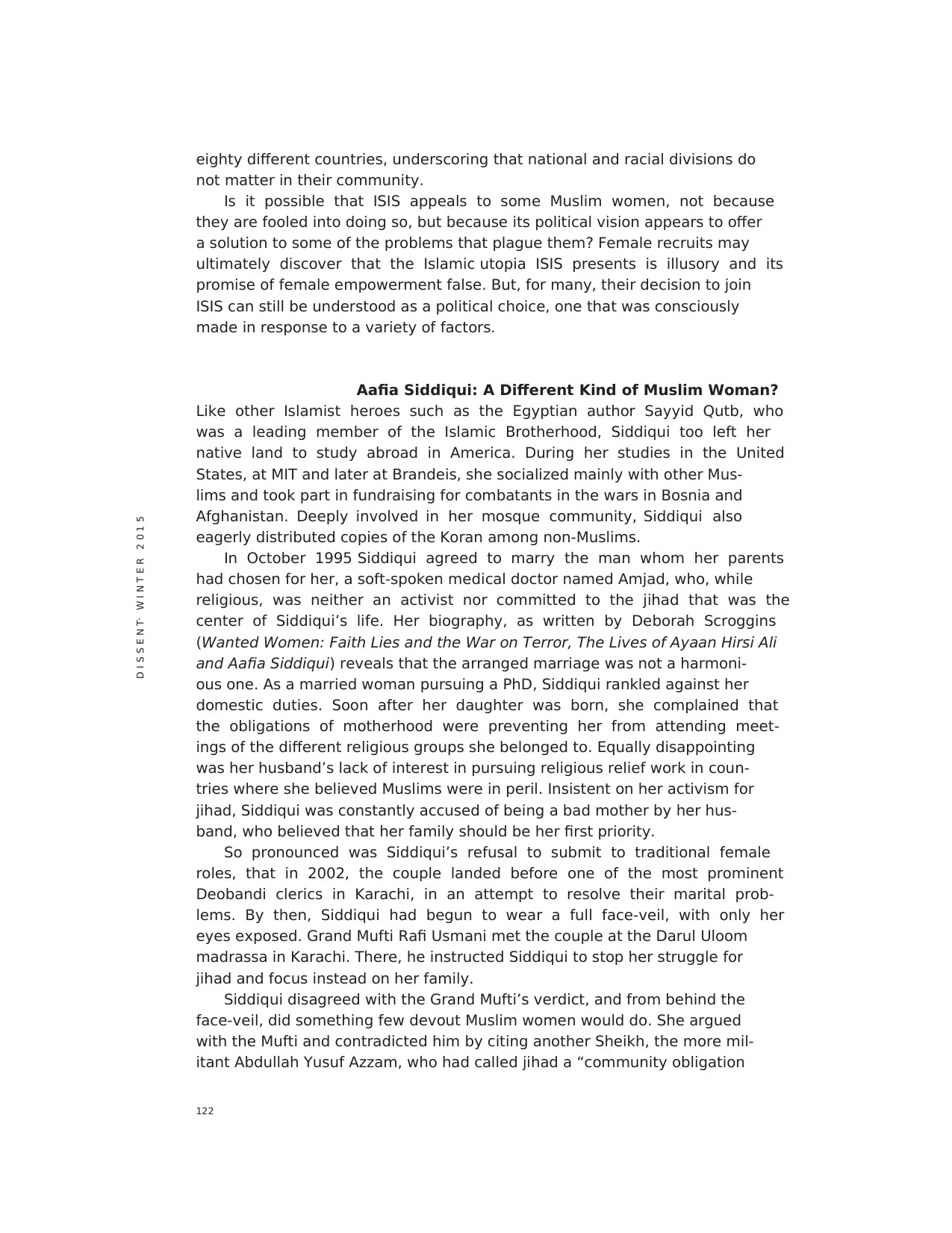
122
D I S S E N T· W I N T E R 2 0 1 5
eighty different countries, underscoring that national and racial divisions do
not matter in their community.
Is it possible that ISIS appeals to some Muslim women, not because
they are fooled into doing so, but because its political vision appears to offer
a solution to some of the problems that plague them? Female recruits may
ultimately discover that the Islamic utopia ISIS presents is illusory and its
promise of female empowerment false. But, for many, their decision to join
ISIS can still be understood as a political choice, one that was consciously
made in response to a variety of factors.
Aafia Siddiqui: A Different Kind of Muslim Woman?
Like other Islamist heroes such as the Egyptian author Sayyid Qutb, who
was a leading member of the Islamic Brotherhood, Siddiqui too left her
native land to study abroad in America. During her studies in the United
States, at MIT and later at Brandeis, she socialized mainly with other Mus-
lims and took part in fundraising for combatants in the wars in Bosnia and
Afghanistan. Deeply involved in her mosque community, Siddiqui also
eagerly distributed copies of the Koran among non-Muslims.
In October 1995 Siddiqui agreed to marry the man whom her parents
had chosen for her, a soft-spoken medical doctor named Amjad, who, while
religious, was neither an activist nor committed to the jihad that was the
center of Siddiqui’s life. Her biography, as written by Deborah Scroggins
(Wanted Women: Faith Lies and the War on Terror, The Lives of Ayaan Hirsi Ali
and Aafia Siddiqui) reveals that the arranged marriage was not a harmoni-
ous one. As a married woman pursuing a PhD, Siddiqui rankled against her
domestic duties. Soon after her daughter was born, she complained that
the obligations of motherhood were preventing her from attending meet-
ings of the different religious groups she belonged to. Equally disappointing
was her husband’s lack of interest in pursuing religious relief work in coun-
tries where she believed Muslims were in peril. Insistent on her activism for
jihad, Siddiqui was constantly accused of being a bad mother by her hus-
band, who believed that her family should be her first priority.
So pronounced was Siddiqui’s refusal to submit to traditional female
roles, that in 2002, the couple landed before one of the most prominent
Deobandi clerics in Karachi, in an attempt to resolve their marital prob-
lems. By then, Siddiqui had begun to wear a full face-veil, with only her
eyes exposed. Grand Mufti Rafi Usmani met the couple at the Darul Uloom
madrassa in Karachi. There, he instructed Siddiqui to stop her struggle for
jihad and focus instead on her family.
Siddiqui disagreed with the Grand Mufti’s verdict, and from behind the
face-veil, did something few devout Muslim women would do. She argued
with the Mufti and contradicted him by citing another Sheikh, the more mil-
itant Abdullah Yusuf Azzam, who had called jihad a “community obligation
D I S S E N T· W I N T E R 2 0 1 5
eighty different countries, underscoring that national and racial divisions do
not matter in their community.
Is it possible that ISIS appeals to some Muslim women, not because
they are fooled into doing so, but because its political vision appears to offer
a solution to some of the problems that plague them? Female recruits may
ultimately discover that the Islamic utopia ISIS presents is illusory and its
promise of female empowerment false. But, for many, their decision to join
ISIS can still be understood as a political choice, one that was consciously
made in response to a variety of factors.
Aafia Siddiqui: A Different Kind of Muslim Woman?
Like other Islamist heroes such as the Egyptian author Sayyid Qutb, who
was a leading member of the Islamic Brotherhood, Siddiqui too left her
native land to study abroad in America. During her studies in the United
States, at MIT and later at Brandeis, she socialized mainly with other Mus-
lims and took part in fundraising for combatants in the wars in Bosnia and
Afghanistan. Deeply involved in her mosque community, Siddiqui also
eagerly distributed copies of the Koran among non-Muslims.
In October 1995 Siddiqui agreed to marry the man whom her parents
had chosen for her, a soft-spoken medical doctor named Amjad, who, while
religious, was neither an activist nor committed to the jihad that was the
center of Siddiqui’s life. Her biography, as written by Deborah Scroggins
(Wanted Women: Faith Lies and the War on Terror, The Lives of Ayaan Hirsi Ali
and Aafia Siddiqui) reveals that the arranged marriage was not a harmoni-
ous one. As a married woman pursuing a PhD, Siddiqui rankled against her
domestic duties. Soon after her daughter was born, she complained that
the obligations of motherhood were preventing her from attending meet-
ings of the different religious groups she belonged to. Equally disappointing
was her husband’s lack of interest in pursuing religious relief work in coun-
tries where she believed Muslims were in peril. Insistent on her activism for
jihad, Siddiqui was constantly accused of being a bad mother by her hus-
band, who believed that her family should be her first priority.
So pronounced was Siddiqui’s refusal to submit to traditional female
roles, that in 2002, the couple landed before one of the most prominent
Deobandi clerics in Karachi, in an attempt to resolve their marital prob-
lems. By then, Siddiqui had begun to wear a full face-veil, with only her
eyes exposed. Grand Mufti Rafi Usmani met the couple at the Darul Uloom
madrassa in Karachi. There, he instructed Siddiqui to stop her struggle for
jihad and focus instead on her family.
Siddiqui disagreed with the Grand Mufti’s verdict, and from behind the
face-veil, did something few devout Muslim women would do. She argued
with the Mufti and contradicted him by citing another Sheikh, the more mil-
itant Abdullah Yusuf Azzam, who had called jihad a “community obligation
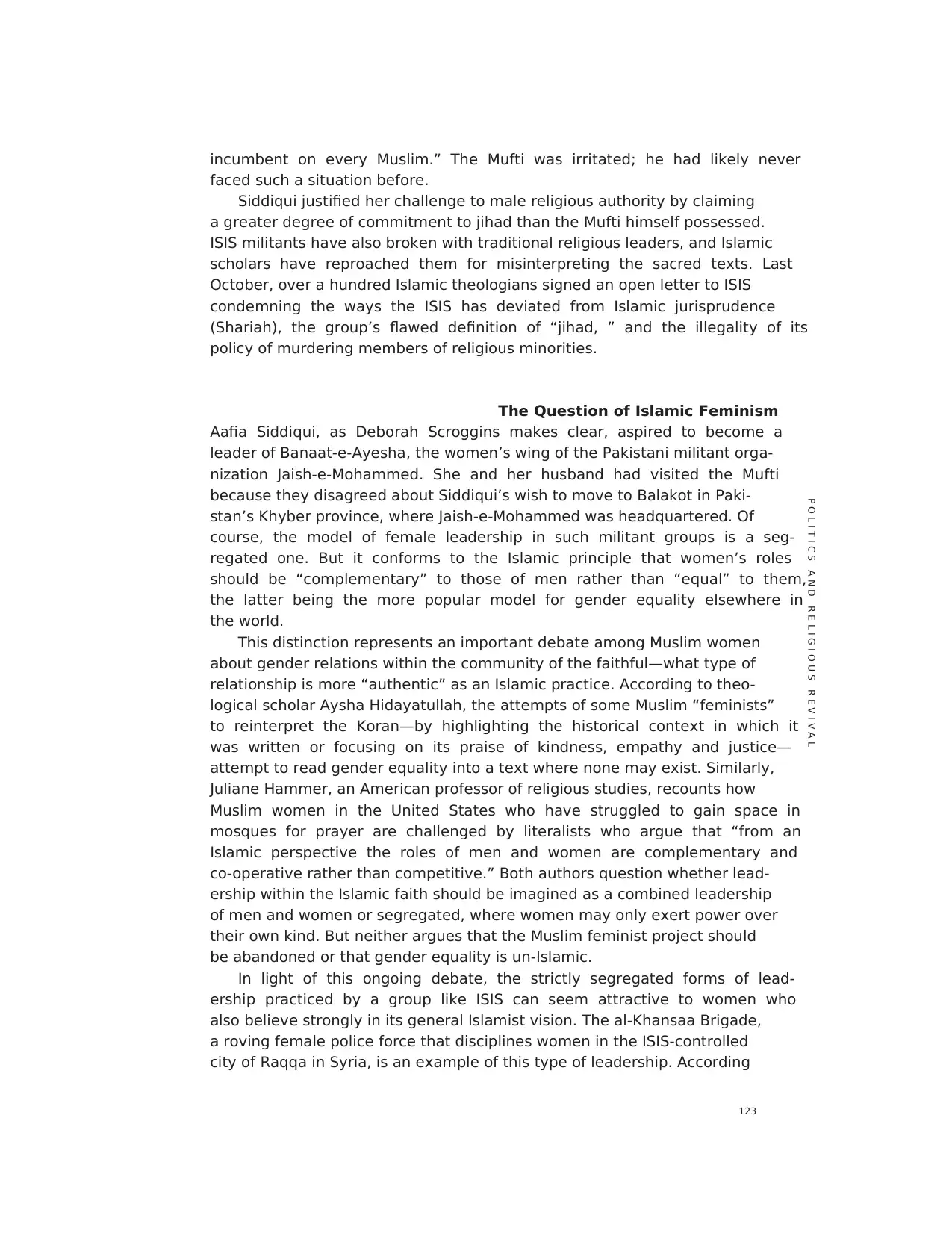
123
P O L I T I C S A N D R E L I G I O U S R E V I V A L
incumbent on every Muslim.” The Mufti was irritated; he had likely never
faced such a situation before.
Siddiqui justified her challenge to male religious authority by claiming
a greater degree of commitment to jihad than the Mufti himself possessed.
ISIS militants have also broken with traditional religious leaders, and Islamic
scholars have reproached them for misinterpreting the sacred texts. Last
October, over a hundred Islamic theologians signed an open letter to ISIS
condemning the ways the ISIS has deviated from Islamic jurisprudence
(Shariah), the group’s flawed definition of “jihad, ” and the illegality of its
policy of murdering members of religious minorities.
The Question of Islamic Feminism
Aafia Siddiqui, as Deborah Scroggins makes clear, aspired to become a
leader of Banaat-e-Ayesha, the women’s wing of the Pakistani militant orga-
nization Jaish-e-Mohammed. She and her husband had visited the Mufti
because they disagreed about Siddiqui’s wish to move to Balakot in Paki-
stan’s Khyber province, where Jaish-e-Mohammed was headquartered. Of
course, the model of female leadership in such militant groups is a seg-
regated one. But it conforms to the Islamic principle that women’s roles
should be “complementary” to those of men rather than “equal” to them,
the latter being the more popular model for gender equality elsewhere in
the world.
This distinction represents an important debate among Muslim women
about gender relations within the community of the faithful—what type of
relationship is more “authentic” as an Islamic practice. According to theo-
logical scholar Aysha Hidayatullah, the attempts of some Muslim “feminists”
to reinterpret the Koran—by highlighting the historical context in which it
was written or focusing on its praise of kindness, empathy and justice—
attempt to read gender equality into a text where none may exist. Similarly,
Juliane Hammer, an American professor of religious studies, recounts how
Muslim women in the United States who have struggled to gain space in
mosques for prayer are challenged by literalists who argue that “from an
Islamic perspective the roles of men and women are complementary and
co-operative rather than competitive.” Both authors question whether lead-
ership within the Islamic faith should be imagined as a combined leadership
of men and women or segregated, where women may only exert power over
their own kind. But neither argues that the Muslim feminist project should
be abandoned or that gender equality is un-Islamic.
In light of this ongoing debate, the strictly segregated forms of lead-
ership practiced by a group like ISIS can seem attractive to women who
also believe strongly in its general Islamist vision. The al-Khansaa Brigade,
a roving female police force that disciplines women in the ISIS-controlled
city of Raqqa in Syria, is an example of this type of leadership. According
P O L I T I C S A N D R E L I G I O U S R E V I V A L
incumbent on every Muslim.” The Mufti was irritated; he had likely never
faced such a situation before.
Siddiqui justified her challenge to male religious authority by claiming
a greater degree of commitment to jihad than the Mufti himself possessed.
ISIS militants have also broken with traditional religious leaders, and Islamic
scholars have reproached them for misinterpreting the sacred texts. Last
October, over a hundred Islamic theologians signed an open letter to ISIS
condemning the ways the ISIS has deviated from Islamic jurisprudence
(Shariah), the group’s flawed definition of “jihad, ” and the illegality of its
policy of murdering members of religious minorities.
The Question of Islamic Feminism
Aafia Siddiqui, as Deborah Scroggins makes clear, aspired to become a
leader of Banaat-e-Ayesha, the women’s wing of the Pakistani militant orga-
nization Jaish-e-Mohammed. She and her husband had visited the Mufti
because they disagreed about Siddiqui’s wish to move to Balakot in Paki-
stan’s Khyber province, where Jaish-e-Mohammed was headquartered. Of
course, the model of female leadership in such militant groups is a seg-
regated one. But it conforms to the Islamic principle that women’s roles
should be “complementary” to those of men rather than “equal” to them,
the latter being the more popular model for gender equality elsewhere in
the world.
This distinction represents an important debate among Muslim women
about gender relations within the community of the faithful—what type of
relationship is more “authentic” as an Islamic practice. According to theo-
logical scholar Aysha Hidayatullah, the attempts of some Muslim “feminists”
to reinterpret the Koran—by highlighting the historical context in which it
was written or focusing on its praise of kindness, empathy and justice—
attempt to read gender equality into a text where none may exist. Similarly,
Juliane Hammer, an American professor of religious studies, recounts how
Muslim women in the United States who have struggled to gain space in
mosques for prayer are challenged by literalists who argue that “from an
Islamic perspective the roles of men and women are complementary and
co-operative rather than competitive.” Both authors question whether lead-
ership within the Islamic faith should be imagined as a combined leadership
of men and women or segregated, where women may only exert power over
their own kind. But neither argues that the Muslim feminist project should
be abandoned or that gender equality is un-Islamic.
In light of this ongoing debate, the strictly segregated forms of lead-
ership practiced by a group like ISIS can seem attractive to women who
also believe strongly in its general Islamist vision. The al-Khansaa Brigade,
a roving female police force that disciplines women in the ISIS-controlled
city of Raqqa in Syria, is an example of this type of leadership. According
Secure Best Marks with AI Grader
Need help grading? Try our AI Grader for instant feedback on your assignments.
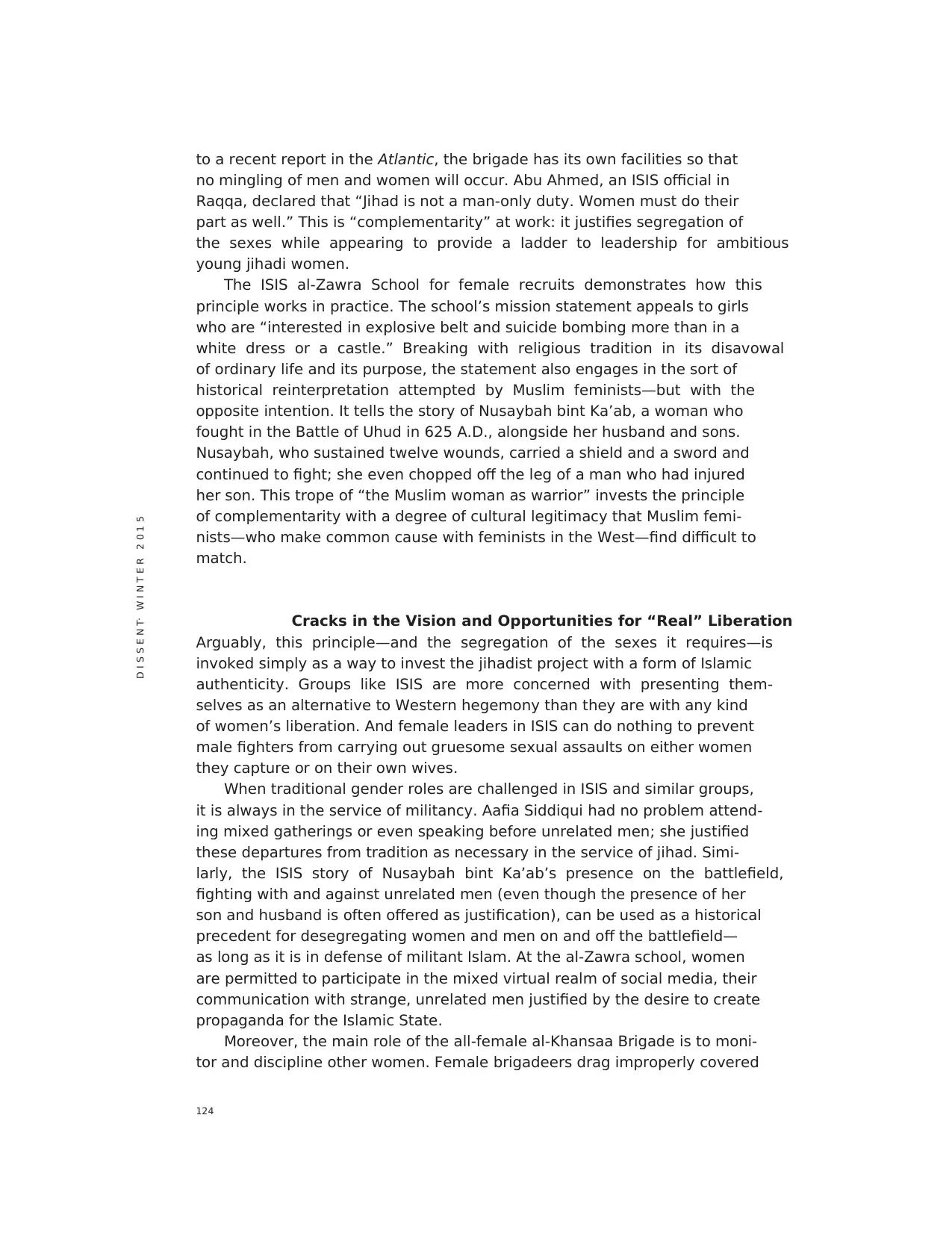
124
D I S S E N T· W I N T E R 2 0 1 5
to a recent report in the Atlantic, the brigade has its own facilities so that
no mingling of men and women will occur. Abu Ahmed, an ISIS official in
Raqqa, declared that “Jihad is not a man-only duty. Women must do their
part as well.” This is “complementarity” at work: it justifies segregation of
the sexes while appearing to provide a ladder to leadership for ambitious
young jihadi women.
The ISIS al-Zawra School for female recruits demonstrates how this
principle works in practice. The school’s mission statement appeals to girls
who are “interested in explosive belt and suicide bombing more than in a
white dress or a castle.” Breaking with religious tradition in its disavowal
of ordinary life and its purpose, the statement also engages in the sort of
historical reinterpretation attempted by Muslim feminists—but with the
opposite intention. It tells the story of Nusaybah bint Ka’ab, a woman who
fought in the Battle of Uhud in 625 A.D., alongside her husband and sons.
Nusaybah, who sustained twelve wounds, carried a shield and a sword and
continued to fight; she even chopped off the leg of a man who had injured
her son. This trope of “the Muslim woman as warrior” invests the principle
of complementarity with a degree of cultural legitimacy that Muslim femi-
nists—who make common cause with feminists in the West—find difficult to
match.
Cracks in the Vision and Opportunities for “Real” Liberation
Arguably, this principle—and the segregation of the sexes it requires—is
invoked simply as a way to invest the jihadist project with a form of Islamic
authenticity. Groups like ISIS are more concerned with presenting them-
selves as an alternative to Western hegemony than they are with any kind
of women’s liberation. And female leaders in ISIS can do nothing to prevent
male fighters from carrying out gruesome sexual assaults on either women
they capture or on their own wives.
When traditional gender roles are challenged in ISIS and similar groups,
it is always in the service of militancy. Aafia Siddiqui had no problem attend-
ing mixed gatherings or even speaking before unrelated men; she justified
these departures from tradition as necessary in the service of jihad. Simi-
larly, the ISIS story of Nusaybah bint Ka’ab’s presence on the battlefield,
fighting with and against unrelated men (even though the presence of her
son and husband is often offered as justification), can be used as a historical
precedent for desegregating women and men on and off the battlefield—
as long as it is in defense of militant Islam. At the al-Zawra school, women
are permitted to participate in the mixed virtual realm of social media, their
communication with strange, unrelated men justified by the desire to create
propaganda for the Islamic State.
Moreover, the main role of the all-female al-Khansaa Brigade is to moni-
tor and discipline other women. Female brigadeers drag improperly covered
D I S S E N T· W I N T E R 2 0 1 5
to a recent report in the Atlantic, the brigade has its own facilities so that
no mingling of men and women will occur. Abu Ahmed, an ISIS official in
Raqqa, declared that “Jihad is not a man-only duty. Women must do their
part as well.” This is “complementarity” at work: it justifies segregation of
the sexes while appearing to provide a ladder to leadership for ambitious
young jihadi women.
The ISIS al-Zawra School for female recruits demonstrates how this
principle works in practice. The school’s mission statement appeals to girls
who are “interested in explosive belt and suicide bombing more than in a
white dress or a castle.” Breaking with religious tradition in its disavowal
of ordinary life and its purpose, the statement also engages in the sort of
historical reinterpretation attempted by Muslim feminists—but with the
opposite intention. It tells the story of Nusaybah bint Ka’ab, a woman who
fought in the Battle of Uhud in 625 A.D., alongside her husband and sons.
Nusaybah, who sustained twelve wounds, carried a shield and a sword and
continued to fight; she even chopped off the leg of a man who had injured
her son. This trope of “the Muslim woman as warrior” invests the principle
of complementarity with a degree of cultural legitimacy that Muslim femi-
nists—who make common cause with feminists in the West—find difficult to
match.
Cracks in the Vision and Opportunities for “Real” Liberation
Arguably, this principle—and the segregation of the sexes it requires—is
invoked simply as a way to invest the jihadist project with a form of Islamic
authenticity. Groups like ISIS are more concerned with presenting them-
selves as an alternative to Western hegemony than they are with any kind
of women’s liberation. And female leaders in ISIS can do nothing to prevent
male fighters from carrying out gruesome sexual assaults on either women
they capture or on their own wives.
When traditional gender roles are challenged in ISIS and similar groups,
it is always in the service of militancy. Aafia Siddiqui had no problem attend-
ing mixed gatherings or even speaking before unrelated men; she justified
these departures from tradition as necessary in the service of jihad. Simi-
larly, the ISIS story of Nusaybah bint Ka’ab’s presence on the battlefield,
fighting with and against unrelated men (even though the presence of her
son and husband is often offered as justification), can be used as a historical
precedent for desegregating women and men on and off the battlefield—
as long as it is in defense of militant Islam. At the al-Zawra school, women
are permitted to participate in the mixed virtual realm of social media, their
communication with strange, unrelated men justified by the desire to create
propaganda for the Islamic State.
Moreover, the main role of the all-female al-Khansaa Brigade is to moni-
tor and discipline other women. Female brigadeers drag improperly covered
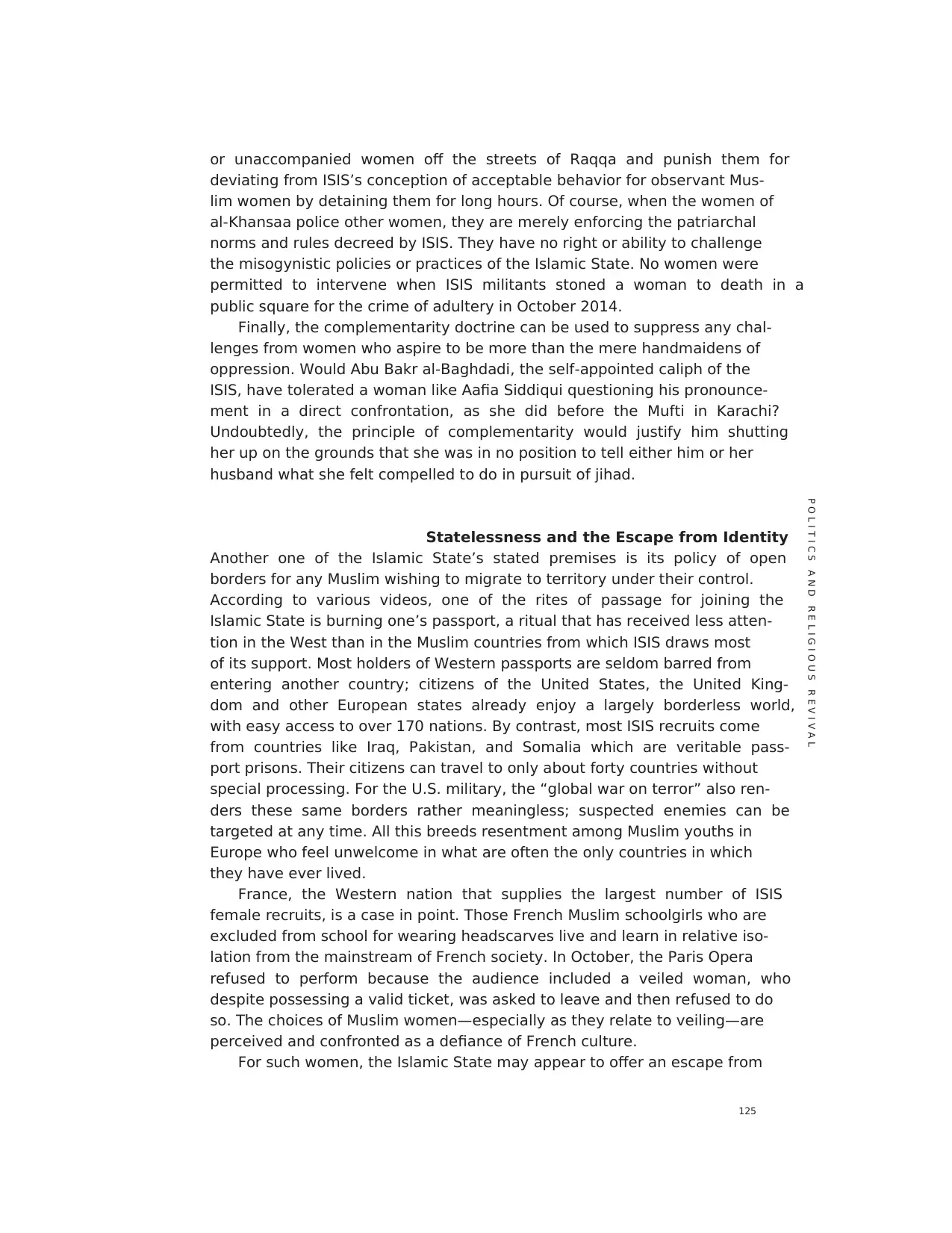
125
P O L I T I C S A N D R E L I G I O U S R E V I V A L
or unaccompanied women off the streets of Raqqa and punish them for
deviating from ISIS’s conception of acceptable behavior for observant Mus-
lim women by detaining them for long hours. Of course, when the women of
al-Khansaa police other women, they are merely enforcing the patriarchal
norms and rules decreed by ISIS. They have no right or ability to challenge
the misogynistic policies or practices of the Islamic State. No women were
permitted to intervene when ISIS militants stoned a woman to death in a
public square for the crime of adultery in October 2014.
Finally, the complementarity doctrine can be used to suppress any chal-
lenges from women who aspire to be more than the mere handmaidens of
oppression. Would Abu Bakr al-Baghdadi, the self-appointed caliph of the
ISIS, have tolerated a woman like Aafia Siddiqui questioning his pronounce-
ment in a direct confrontation, as she did before the Mufti in Karachi?
Undoubtedly, the principle of complementarity would justify him shutting
her up on the grounds that she was in no position to tell either him or her
husband what she felt compelled to do in pursuit of jihad.
Statelessness and the Escape from Identity
Another one of the Islamic State’s stated premises is its policy of open
borders for any Muslim wishing to migrate to territory under their control.
According to various videos, one of the rites of passage for joining the
Islamic State is burning one’s passport, a ritual that has received less atten-
tion in the West than in the Muslim countries from which ISIS draws most
of its support. Most holders of Western passports are seldom barred from
entering another country; citizens of the United States, the United King-
dom and other European states already enjoy a largely borderless world,
with easy access to over 170 nations. By contrast, most ISIS recruits come
from countries like Iraq, Pakistan, and Somalia which are veritable pass-
port prisons. Their citizens can travel to only about forty countries without
special processing. For the U.S. military, the “global war on terror” also ren-
ders these same borders rather meaningless; suspected enemies can be
targeted at any time. All this breeds resentment among Muslim youths in
Europe who feel unwelcome in what are often the only countries in which
they have ever lived.
France, the Western nation that supplies the largest number of ISIS
female recruits, is a case in point. Those French Muslim schoolgirls who are
excluded from school for wearing headscarves live and learn in relative iso-
lation from the mainstream of French society. In October, the Paris Opera
refused to perform because the audience included a veiled woman, who
despite possessing a valid ticket, was asked to leave and then refused to do
so. The choices of Muslim women—especially as they relate to veiling—are
perceived and confronted as a defiance of French culture.
For such women, the Islamic State may appear to offer an escape from
P O L I T I C S A N D R E L I G I O U S R E V I V A L
or unaccompanied women off the streets of Raqqa and punish them for
deviating from ISIS’s conception of acceptable behavior for observant Mus-
lim women by detaining them for long hours. Of course, when the women of
al-Khansaa police other women, they are merely enforcing the patriarchal
norms and rules decreed by ISIS. They have no right or ability to challenge
the misogynistic policies or practices of the Islamic State. No women were
permitted to intervene when ISIS militants stoned a woman to death in a
public square for the crime of adultery in October 2014.
Finally, the complementarity doctrine can be used to suppress any chal-
lenges from women who aspire to be more than the mere handmaidens of
oppression. Would Abu Bakr al-Baghdadi, the self-appointed caliph of the
ISIS, have tolerated a woman like Aafia Siddiqui questioning his pronounce-
ment in a direct confrontation, as she did before the Mufti in Karachi?
Undoubtedly, the principle of complementarity would justify him shutting
her up on the grounds that she was in no position to tell either him or her
husband what she felt compelled to do in pursuit of jihad.
Statelessness and the Escape from Identity
Another one of the Islamic State’s stated premises is its policy of open
borders for any Muslim wishing to migrate to territory under their control.
According to various videos, one of the rites of passage for joining the
Islamic State is burning one’s passport, a ritual that has received less atten-
tion in the West than in the Muslim countries from which ISIS draws most
of its support. Most holders of Western passports are seldom barred from
entering another country; citizens of the United States, the United King-
dom and other European states already enjoy a largely borderless world,
with easy access to over 170 nations. By contrast, most ISIS recruits come
from countries like Iraq, Pakistan, and Somalia which are veritable pass-
port prisons. Their citizens can travel to only about forty countries without
special processing. For the U.S. military, the “global war on terror” also ren-
ders these same borders rather meaningless; suspected enemies can be
targeted at any time. All this breeds resentment among Muslim youths in
Europe who feel unwelcome in what are often the only countries in which
they have ever lived.
France, the Western nation that supplies the largest number of ISIS
female recruits, is a case in point. Those French Muslim schoolgirls who are
excluded from school for wearing headscarves live and learn in relative iso-
lation from the mainstream of French society. In October, the Paris Opera
refused to perform because the audience included a veiled woman, who
despite possessing a valid ticket, was asked to leave and then refused to do
so. The choices of Muslim women—especially as they relate to veiling—are
perceived and confronted as a defiance of French culture.
For such women, the Islamic State may appear to offer an escape from
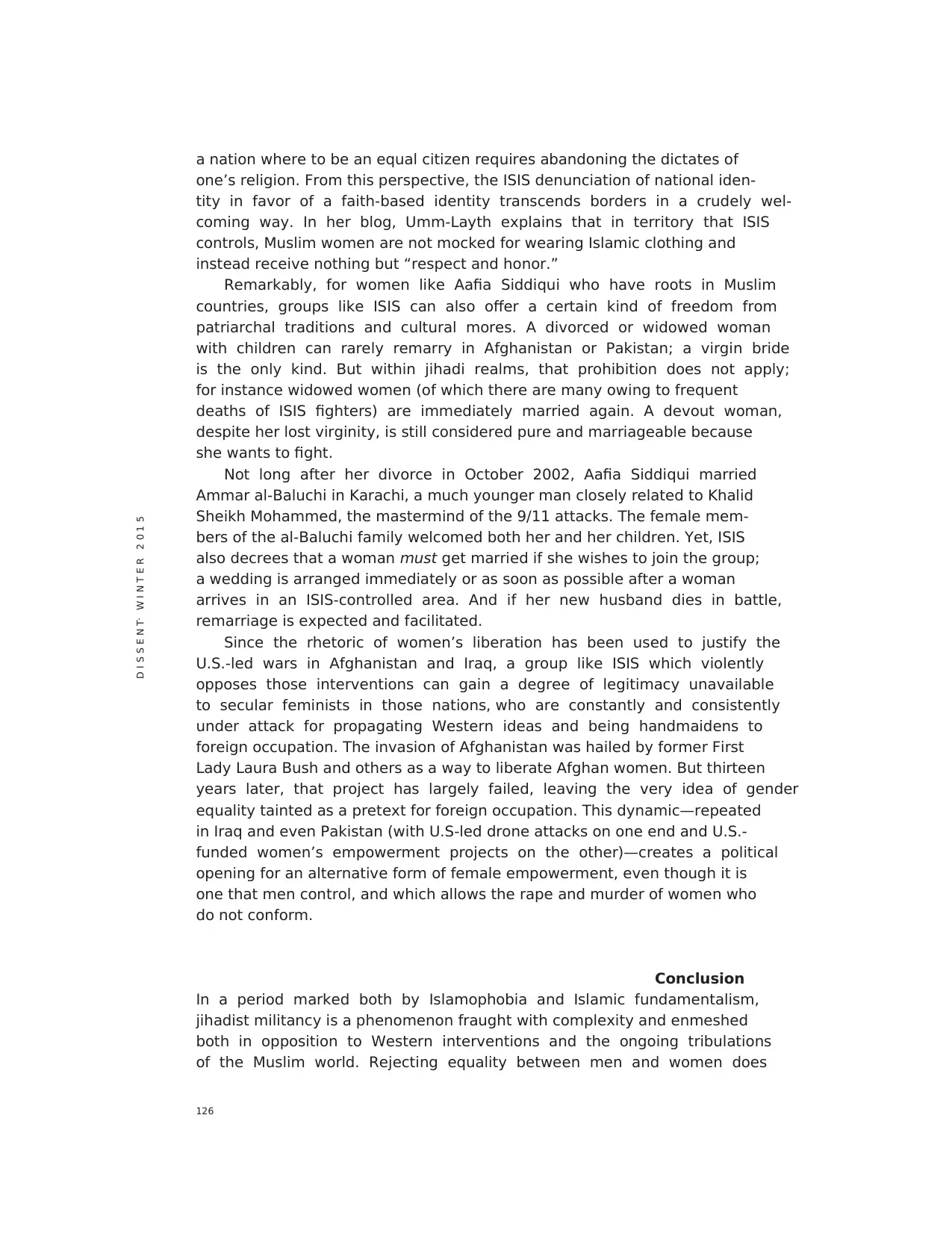
126
D I S S E N T· W I N T E R 2 0 1 5
a nation where to be an equal citizen requires abandoning the dictates of
one’s religion. From this perspective, the ISIS denunciation of national iden-
tity in favor of a faith-based identity transcends borders in a crudely wel-
coming way. In her blog, Umm-Layth explains that in territory that ISIS
controls, Muslim women are not mocked for wearing Islamic clothing and
instead receive nothing but “respect and honor.”
Remarkably, for women like Aafia Siddiqui who have roots in Muslim
countries, groups like ISIS can also offer a certain kind of freedom from
patriarchal traditions and cultural mores. A divorced or widowed woman
with children can rarely remarry in Afghanistan or Pakistan; a virgin bride
is the only kind. But within jihadi realms, that prohibition does not apply;
for instance widowed women (of which there are many owing to frequent
deaths of ISIS fighters) are immediately married again. A devout woman,
despite her lost virginity, is still considered pure and marriageable because
she wants to fight.
Not long after her divorce in October 2002, Aafia Siddiqui married
Ammar al-Baluchi in Karachi, a much younger man closely related to Khalid
Sheikh Mohammed, the mastermind of the 9/11 attacks. The female mem-
bers of the al-Baluchi family welcomed both her and her children. Yet, ISIS
also decrees that a woman must get married if she wishes to join the group;
a wedding is arranged immediately or as soon as possible after a woman
arrives in an ISIS-controlled area. And if her new husband dies in battle,
remarriage is expected and facilitated.
Since the rhetoric of women’s liberation has been used to justify the
U.S.-led wars in Afghanistan and Iraq, a group like ISIS which violently
opposes those interventions can gain a degree of legitimacy unavailable
to secular feminists in those nations, who are constantly and consistently
under attack for propagating Western ideas and being handmaidens to
foreign occupation. The invasion of Afghanistan was hailed by former First
Lady Laura Bush and others as a way to liberate Afghan women. But thirteen
years later, that project has largely failed, leaving the very idea of gender
equality tainted as a pretext for foreign occupation. This dynamic—repeated
in Iraq and even Pakistan (with U.S-led drone attacks on one end and U.S.-
funded women’s empowerment projects on the other)—creates a political
opening for an alternative form of female empowerment, even though it is
one that men control, and which allows the rape and murder of women who
do not conform.
Conclusion
In a period marked both by Islamophobia and Islamic fundamentalism,
jihadist militancy is a phenomenon fraught with complexity and enmeshed
both in opposition to Western interventions and the ongoing tribulations
of the Muslim world. Rejecting equality between men and women does
D I S S E N T· W I N T E R 2 0 1 5
a nation where to be an equal citizen requires abandoning the dictates of
one’s religion. From this perspective, the ISIS denunciation of national iden-
tity in favor of a faith-based identity transcends borders in a crudely wel-
coming way. In her blog, Umm-Layth explains that in territory that ISIS
controls, Muslim women are not mocked for wearing Islamic clothing and
instead receive nothing but “respect and honor.”
Remarkably, for women like Aafia Siddiqui who have roots in Muslim
countries, groups like ISIS can also offer a certain kind of freedom from
patriarchal traditions and cultural mores. A divorced or widowed woman
with children can rarely remarry in Afghanistan or Pakistan; a virgin bride
is the only kind. But within jihadi realms, that prohibition does not apply;
for instance widowed women (of which there are many owing to frequent
deaths of ISIS fighters) are immediately married again. A devout woman,
despite her lost virginity, is still considered pure and marriageable because
she wants to fight.
Not long after her divorce in October 2002, Aafia Siddiqui married
Ammar al-Baluchi in Karachi, a much younger man closely related to Khalid
Sheikh Mohammed, the mastermind of the 9/11 attacks. The female mem-
bers of the al-Baluchi family welcomed both her and her children. Yet, ISIS
also decrees that a woman must get married if she wishes to join the group;
a wedding is arranged immediately or as soon as possible after a woman
arrives in an ISIS-controlled area. And if her new husband dies in battle,
remarriage is expected and facilitated.
Since the rhetoric of women’s liberation has been used to justify the
U.S.-led wars in Afghanistan and Iraq, a group like ISIS which violently
opposes those interventions can gain a degree of legitimacy unavailable
to secular feminists in those nations, who are constantly and consistently
under attack for propagating Western ideas and being handmaidens to
foreign occupation. The invasion of Afghanistan was hailed by former First
Lady Laura Bush and others as a way to liberate Afghan women. But thirteen
years later, that project has largely failed, leaving the very idea of gender
equality tainted as a pretext for foreign occupation. This dynamic—repeated
in Iraq and even Pakistan (with U.S-led drone attacks on one end and U.S.-
funded women’s empowerment projects on the other)—creates a political
opening for an alternative form of female empowerment, even though it is
one that men control, and which allows the rape and murder of women who
do not conform.
Conclusion
In a period marked both by Islamophobia and Islamic fundamentalism,
jihadist militancy is a phenomenon fraught with complexity and enmeshed
both in opposition to Western interventions and the ongoing tribulations
of the Muslim world. Rejecting equality between men and women does
Paraphrase This Document
Need a fresh take? Get an instant paraphrase of this document with our AI Paraphraser
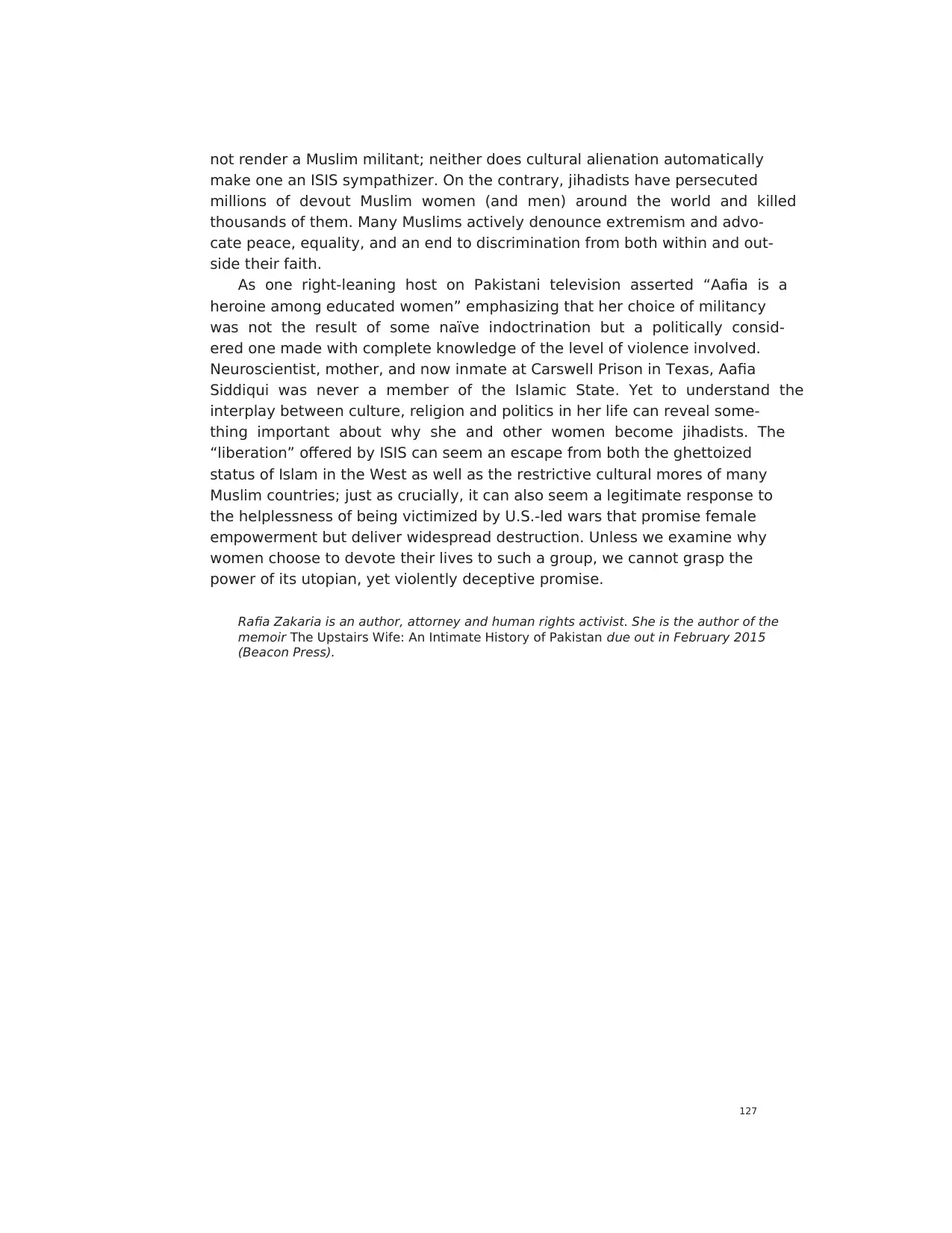
127
not render a Muslim militant; neither does cultural alienation automatically
make one an ISIS sympathizer. On the contrary, jihadists have persecuted
millions of devout Muslim women (and men) around the world and killed
thousands of them. Many Muslims actively denounce extremism and advo-
cate peace, equality, and an end to discrimination from both within and out-
side their faith.
As one right-leaning host on Pakistani television asserted “Aafia is a
heroine among educated women” emphasizing that her choice of militancy
was not the result of some naïve indoctrination but a politically consid-
ered one made with complete knowledge of the level of violence involved.
Neuroscientist, mother, and now inmate at Carswell Prison in Texas, Aafia
Siddiqui was never a member of the Islamic State. Yet to understand the
interplay between culture, religion and politics in her life can reveal some-
thing important about why she and other women become jihadists. The
“liberation” offered by ISIS can seem an escape from both the ghettoized
status of Islam in the West as well as the restrictive cultural mores of many
Muslim countries; just as crucially, it can also seem a legitimate response to
the helplessness of being victimized by U.S.-led wars that promise female
empowerment but deliver widespread destruction. Unless we examine why
women choose to devote their lives to such a group, we cannot grasp the
power of its utopian, yet violently deceptive promise.
Rafia Zakaria is an author, attorney and human rights activist. She is the author of the
memoir The Upstairs Wife: An Intimate History of Pakistan due out in February 2015
(Beacon Press).
not render a Muslim militant; neither does cultural alienation automatically
make one an ISIS sympathizer. On the contrary, jihadists have persecuted
millions of devout Muslim women (and men) around the world and killed
thousands of them. Many Muslims actively denounce extremism and advo-
cate peace, equality, and an end to discrimination from both within and out-
side their faith.
As one right-leaning host on Pakistani television asserted “Aafia is a
heroine among educated women” emphasizing that her choice of militancy
was not the result of some naïve indoctrination but a politically consid-
ered one made with complete knowledge of the level of violence involved.
Neuroscientist, mother, and now inmate at Carswell Prison in Texas, Aafia
Siddiqui was never a member of the Islamic State. Yet to understand the
interplay between culture, religion and politics in her life can reveal some-
thing important about why she and other women become jihadists. The
“liberation” offered by ISIS can seem an escape from both the ghettoized
status of Islam in the West as well as the restrictive cultural mores of many
Muslim countries; just as crucially, it can also seem a legitimate response to
the helplessness of being victimized by U.S.-led wars that promise female
empowerment but deliver widespread destruction. Unless we examine why
women choose to devote their lives to such a group, we cannot grasp the
power of its utopian, yet violently deceptive promise.
Rafia Zakaria is an author, attorney and human rights activist. She is the author of the
memoir The Upstairs Wife: An Intimate History of Pakistan due out in February 2015
(Beacon Press).
1 out of 8
Your All-in-One AI-Powered Toolkit for Academic Success.
+13062052269
info@desklib.com
Available 24*7 on WhatsApp / Email
![[object Object]](/_next/static/media/star-bottom.7253800d.svg)
Unlock your academic potential
© 2024 | Zucol Services PVT LTD | All rights reserved.